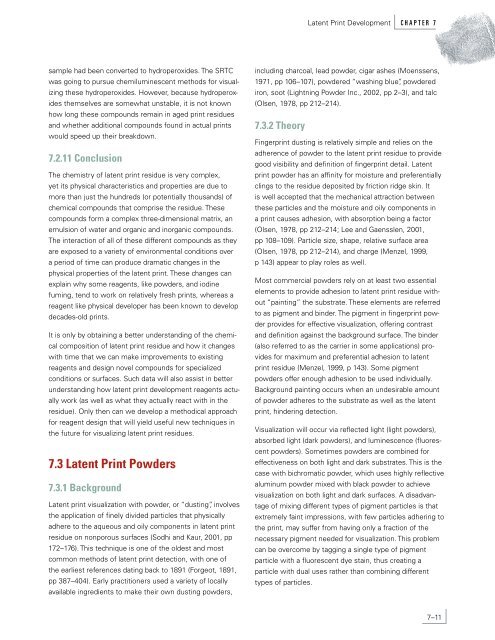Latent Print Development - National Criminal Justice Reference ...
Latent Print Development - National Criminal Justice Reference ...
Latent Print Development - National Criminal Justice Reference ...
Create successful ePaper yourself
Turn your PDF publications into a flip-book with our unique Google optimized e-Paper software.
sample had been converted to hydroperoxides. The SRTC<br />
was going to pursue chemiluminescent methods for visual-<br />
izing these hydroperoxides. However, because hydroperox-<br />
ides themselves are somewhat unstable, it is not known<br />
how long these compounds remain in aged print residues<br />
and whether additional compounds found in actual prints<br />
would speed up their breakdown.<br />
7.2.11 Conclusion<br />
The chemistry of latent print residue is very complex,<br />
yet its physical characteristics and properties are due to<br />
more than just the hundreds (or potentially thousands) of<br />
chemical compounds that comprise the residue. These<br />
compounds form a complex three-dimensional matrix, an<br />
emulsion of water and organic and inorganic compounds.<br />
The interaction of all of these different compounds as they<br />
are exposed to a variety of environmental conditions over<br />
a period of time can produce dramatic changes in the<br />
physical properties of the latent print. These changes can<br />
explain why some reagents, like powders, and iodine<br />
fuming, tend to work on relatively fresh prints, whereas a<br />
reagent like physical developer has been known to develop<br />
decades-old prints.<br />
It is only by obtaining a better understanding of the chemi-<br />
cal composition of latent print residue and how it changes<br />
with time that we can make improvements to existing<br />
reagents and design novel compounds for specialized<br />
conditions or surfaces. Such data will also assist in better<br />
understanding how latent print development reagents actu-<br />
ally work (as well as what they actually react with in the<br />
residue). Only then can we develop a methodical approach<br />
for reagent design that will yield useful new techniques in<br />
the future for visualizing latent print residues.<br />
7.3 <strong>Latent</strong> <strong>Print</strong> Powders<br />
7.3.1 Background<br />
<strong>Latent</strong> print visualization with powder, or “dusting”, involves<br />
the application of finely divided particles that physically<br />
adhere to the aqueous and oily components in latent print<br />
residue on nonporous surfaces (Sodhi and Kaur, 2001, pp<br />
172–176). This technique is one of the oldest and most<br />
common methods of latent print detection, with one of<br />
the earliest references dating back to 1891 (Forgeot, 1891,<br />
pp 387–404). Early practitioners used a variety of locally<br />
available ingredients to make their own dusting powders,<br />
including charcoal, lead powder, cigar ashes (Moenssens,<br />
1971, pp 106–107), powdered “washing blue”, powdered<br />
iron, soot (Lightning Powder Inc., 2002, pp 2–3), and talc<br />
(Olsen, 1978, pp 212–214).<br />
7.3.2 Theory<br />
Fingerprint dusting is relatively simple and relies on the<br />
adherence of powder to the latent print residue to provide<br />
good visibility and definition of fingerprint detail. <strong>Latent</strong><br />
print powder has an affinity for moisture and preferentially<br />
clings to the residue deposited by friction ridge skin. It<br />
is well accepted that the mechanical attraction between<br />
these particles and the moisture and oily components in<br />
a print causes adhesion, with absorption being a factor<br />
(Olsen, 1978, pp 212–214; Lee and Gaensslen, 2001,<br />
pp 108–109). Particle size, shape, relative surface area<br />
(Olsen, 1978, pp 212–214), and charge (Menzel, 1999,<br />
p 143) appear to play roles as well.<br />
Most commercial powders rely on at least two essential<br />
elements to provide adhesion to latent print residue with-<br />
out “painting” the substrate. These elements are referred<br />
to as pigment and binder. The pigment in fingerprint pow-<br />
der provides for effective visualization, offering contrast<br />
and definition against the background surface. The binder<br />
(also referred to as the carrier in some applications) pro-<br />
vides for maximum and preferential adhesion to latent<br />
print residue (Menzel, 1999, p 143). Some pigment<br />
powders offer enough adhesion to be used individually.<br />
Background painting occurs when an undesirable amount<br />
of powder adheres to the substrate as well as the latent<br />
print, hindering detection.<br />
Visualization will occur via reflected light (light powders),<br />
absorbed light (dark powders), and luminescence (fluores-<br />
cent powders). Sometimes powders are combined for<br />
effectiveness on both light and dark substrates. This is the<br />
case with bichromatic powder, which uses highly reflective<br />
aluminum powder mixed with black powder to achieve<br />
visualization on both light and dark surfaces. A disadvan-<br />
tage of mixing different types of pigment particles is that<br />
extremely faint impressions, with few particles adhering to<br />
the print, may suffer from having only a fraction of the<br />
necessary pigment needed for visualization. This problem<br />
can be overcome by tagging a single type of pigment<br />
particle with a fluorescent dye stain, thus creating a<br />
particle with dual uses rather than combining different<br />
types of particles.<br />
<strong>Latent</strong> <strong>Print</strong> <strong>Development</strong> C H A P T E R 7<br />
7–11

















